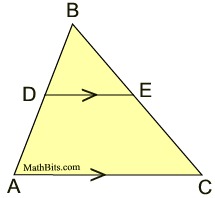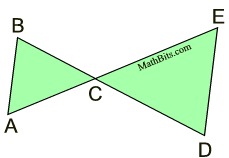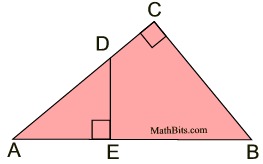|
The basic proof problems involving similar triangles will ask you to prove one of three things:
1. the triangles are similar,
2. a proportion is true, or
3. a product is true. |
Of course, there are additional proof problems that utilize similar triangles to gather needed information about the triangles to prove an unrelated concept.
The examples below will demonstrate the three basic options
typically associated with similar triangle proofs.
| When asked to prove triangles similar: |

Start by looking for 2 sets of congruent angles (AA), since AA is the most popular method for proving triangles similar.
(If AA is not working, your other options
are SSS or SAS for similar triangles.)
|
|
Statements |
Reasons |
|
1. Given |
2. ∠ B  ∠ B
Both triangles share
∠B. |
2. Reflexive property |
3. ∠BDE  ∠A ∠A |
3. If 2 || lines are cut by a transversal, the corresponding angles are congruent. |
4. ΔABC ∼ ΔDBE |
4. AA - if 2∠s of one Δ are  to the corresponding ∠s of another Δ, the Δs are similar. |
|
|
| When asked to prove a proportion to be true: |

Proportions are associated with similar triangles. Start by proving the triangles similar.
If working with multiple triangles, find the triangles whose
sides match the lengths in the proportion.
|
|
Statements |
Reasons |
|
1. Given |
2. ∠ BCA  ∠ DCE |
2. Vertical angles are congruent. |
3. ΔABC ∼ ΔEDC |
3. AA - if 2∠s of one Δ are  to the corresponding ∠s of another Δ, the Δs are similar. |
|
4. The corresponding sides of similar triangles are proportional. |
|
|
| When asked to prove a product to be true: |

When you "cross multiply" a proportion, you will get a product. Prove the triangles are similar, then set up a proportion that will yield this product.
|
|
Statements |
Reasons |
|
1. Given |
2. ∠ C  ∠ DEA |
2. All right angles are congruent. |
3. ∠A  ∠A ∠A |
3. Reflexive property. |
4. ΔADE ∼ ΔABC |
4. AA - if 2∠s of one Δ are  to the corresponding ∠s of another Δ, the Δs are similar. |
|
5. The corresponding sides of similar triangles are proportional. |
|
6. In a proportion, the product of the means equals the product of the extremes. |
|
|

NOTE: The re-posting of materials (in part or whole) from this site to the Internet
is copyright violation
and is not considered "fair use" for educators. Please read the "Terms of Use". |
|








